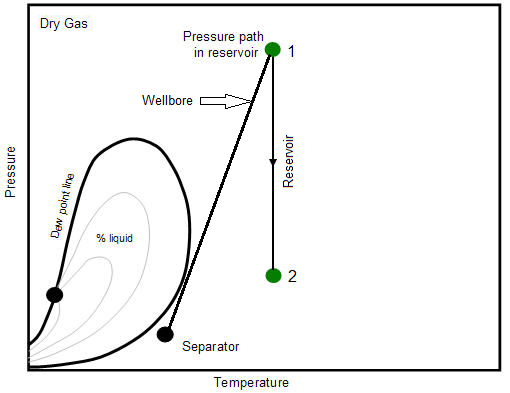Reservoir Fluid Types
Typically, there are five main types of reservoir fluids: black oil, volatile oil, condensate (retrograde gas), wet gas, and dry gas. Each of these fluid types require different approaches when analyzing the reservoir, so it is important to identify the correct fluid type early on in the reservoir's life. Laboratory analysis is our primary method for determining and quantifying fluid type, but production information such as initial production gas-oil ratio (GOR), gravity of the stock-tank liquid, and the color of the stock-tank liquid are also useful indicators.
Black Oils
Black oils are made up of a variety of components including large, heavy, and non-volatile hydrocarbons. The phase diagram is shown below. When the reservoir pressure lies anywhere along line 1 → 2, the oil is said to be undersaturated - meaning the oil could dissolve more gas if more gas were present. If the pressure is at 2, the oil is at its bubble point, and is said to be saturated - meaning the oil contains the maximum amount of dissolved gas and can't hold any more gas. A reduction in pressure at this point will release gas to form a free gas phase inside the reservoir. Additional gas evolves from the oil as it moves from the reservoir to the surface. This causes some shrinkage of the oil. Black oil is often called low shrinkage crude oil or ordinary oil.
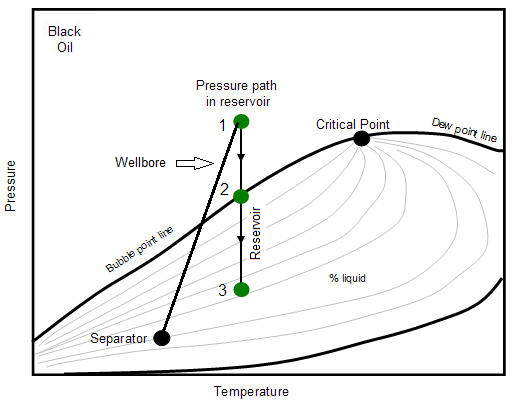
Black oils are dark in color indicating the presence of heavy hydrocarbons. It is characterized as having initial gas-oil ratios of 2000 scf/stb or less. Producing GOR will increase during production when reservoir falls below bubble point pressure, 2 → 3 as the gas evolves from the solution inside the reservoir and flows preferentially to the oil.
Volatile Oils
Volatile oils contain fewer heavy molecules and more intermediate components (ethane through hexane) than black oils. Volatile oils generally have initial gas-oil ratios in the 2000 to 3300 scf/Bbl range, and the stock tank gravity is usually 40° API or higher. The color is generally lighter than black oil – brown, orange, or green. Gas associated with volatile oils tends to be very rich and similar to retrograde condensate gas.
The phase envelope for a volatile oil tends to cover a much narrower temperature range when compared to a black oil; but like a black oil, the reservoir temperature is always lower than the critical temperature for the fluid. As the reservoir temperature approaches the critical temperature a volatile oil will become more gas-like such that with even moderate depletion, a volatile oil reservoir can flash mainly to gas and have a relatively low liquid content.
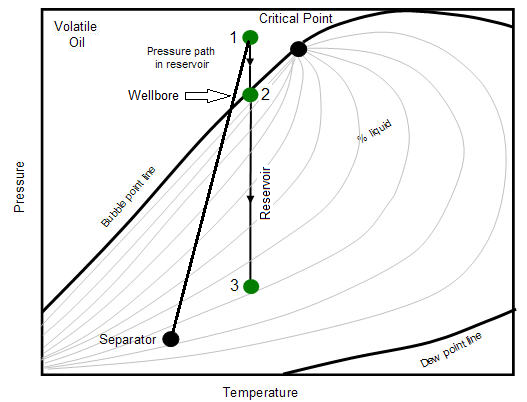
Condensate (Retrograde Gas)
Condensate gas is very similar to volatile oils in terms of the colour (green, orange, brown, even clear) and gravity (40° to 60° API) of the produced oil. However, the reservoir temperature of a condensate gas reservoir is greater than the critical temperature of the fluid, and so where a volatile oil is a liquid at original reservoir pressure and temperature, a condensate gas is a gas.
As pressure is reduced in a condensate gas reservoir, the fluid will pass through the dew point and large volumes of liquid will condense in the reservoir. Since the gas flows preferentially to oil, much of this oil will be unrecoverable. Consequently, it is important to recognize that a reservoir contains a condensate gas and re-inject dry gas to maintain reservoir pressure above the dew point to maximize recovery of the liquids. In the diagram below, the retrograde gas exists completely in a gaseous state inside the reservoir at point 1. As the pressure decreases, the condensate exhibits a dew point at point 2. As the reservoir further depletes and the pressure drops, liquid condenses from the gas to form a free liquid inside the reservoir.
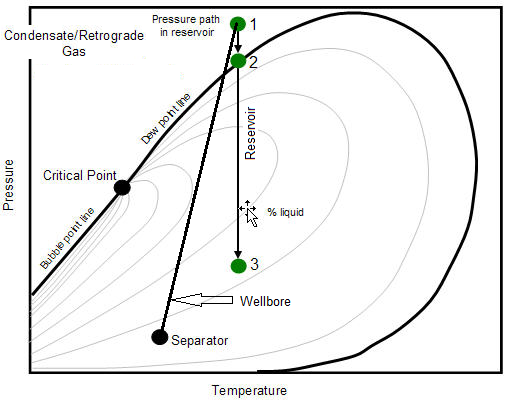
Wet Gas (Rich Gas)
Natural gas that contains significant heavy hydrocarbons such as propane, butane and other liquid hydrocarbons is known as wet gas or rich gas. The general rule of thumb is if the gas contains less methane (typically less than 85% methane) and more ethane, and other more complex hydrocarbons, it is labelled as wet gas.
Wet gas exists solely as a gas in the reservoir throughout the reduction in reservoir pressure. Unlike retrograde condensate, no liquid is formed inside the reservoir. However, separator conditions lie within the phase envelope, causing some liquid to be formed at the surface. This surface liquid is normally called condensate, and the reservoir gas is sometimes called condensate-gas, which leads to a lot of confusion between wet gasses and retrograde condensate.
The entire phase diagram of a wet gas will lie below the reservoir temperature. Note that the pressure path line does not enter the phase envelope, meaning no liquid is ever formed inside the reservoir.
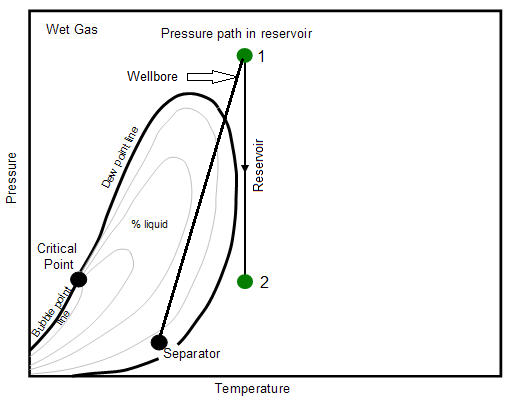
Wet gases produce stock tank liquid with the same range of gravities as the liquids from retrograde gases. However, the gravity of the stock tank liquid does not change during the life of the reservoir. Also, producing GOR are very high ( > 50000 scf/stb) for wet gases and remains constant.
Dry Gas
Natural gas that occurs in the absence of condensate or liquid hydrocarbons, or gas that had condensable hydrocarbons removed, is called dry gas. It is primarily methane with some intermediates. The hydrocarbon mixture is solely gas in the reservoir and there is no liquid (condensate surface liquid) formed either in the reservoir or at surface. The pressure path line does not enter into the phase envelope in the phase diagram, thus there is only dry gas in the reservoir. Note, the surface separator conditions also fall outside the phase envelope (in contrast to wet gas); hence no liquid is formed at the surface separator.
